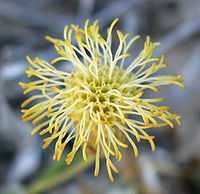Brickellia
| Brickellia | |
|---|---|
 | |
| Brickellia californica | |
| Scientific classification | |
| Kingdom: | Plantae |
| (unranked): | Angiosperms |
| (unranked): | Eudicots |
| (unranked): | Asterids |
| Order: | Asterales |
| Family: | Asteraceae |
| Subfamily: | Asteroideae |
| Tribe: | Eupatorieae |
| Genus: | Brickellia Ell. |
| Species | |
|
About 100-110, see text | |
Brickellia is a genus of about 100[1] to 110[2] species of plants in the aster family, Asteraceae, known commonly as brickellbushes. They are found in North America, Mexico, and Central America.[1] Many species are native to the American southwest, especially Texas. Brickellia is among the more basal lineages of the Eupatorieae and should not be assigned to a subtribe pending further research.[3]
They are mostly woody perennial shrubs. Some species have a very strong pleasant scent, while others smell distasteful. All contain high amounts of essential oils. Germacrene D, a natural insecticide, is found in B. veronicifolia and probably other species, if not all.[4]
Regardless their chemical defense, brickellbushes are food for caterpillars of certain Lepidoptera. These include the noctuid moths Schinia trifascia, Schinia oleagina, which is known only from Brickellia, Schinia buta, which is only known from B. californica, and Schinia gracilenta, which is only known from B. eupatorioides.
Classification
The genera Brickelliastrum (United States and Mexico), Asanthus (United States and Mexico), Dyscritogyne (Mexico), and Steviopsis have been separated from Brickellia by many 20th century authors (and all four combined into Steviopsis by some). Their correct placement is still debated,[5] but molecular phylogenetic analysis has provided evidence that Brickelliastrum, Asanthus, and Steviopsis (including Dyscritogyne, which is not distinct from Steviopsis) represent distinct lineages, and should be recognized as separate from Brickellia.[6]
Diversity



- Brickellia amplexicaulis – earleaf brickellbush
- Brickellia arguta – pungent brickellbush
- Brickellia atractyloides – spearleaf brickellbush, hollyleaf brickellbush
- Brickellia baccharidea – resinleaf brickellbush, baccharisleaf brickellbush
- Brickellia betonicifolia – betonyleaf brickellbush
- Brickellia brachyphylla – plumed brickellbush
- Brickellia californica – California brickellbush, Jepson's brickellbush
- Brickellia chenopodina – chenopod brickellbush
- Brickellia coixtlahuaca[10]
- Brickellia cordifolia – Flyr's nemesis
- Brickellia coulteri – Coulter's brickellbush
- Brickellia cylindracea – gravelbar brickellbush
- Brickellia dentata – leafy brickellbush
- Brickellia desertorum – desert brickellbush
- Brickellia diffusa
- Brickellia eupatorioides – false boneset
- Brickellia floribunda – Chihuahuan brickellbush
- Brickellia frutescens – shrubby brickellbush, rigid brickellbush
- Brickellia glabrata
- Brickellia grandiflora – tassel-flowered brickellbush, mountain brickellbush
- Brickellia greenei – Greene's brickellbush
- Brickellia hinckleyi – Hinckley's brickellbush
- Brickellia huahuapana[10]
- Brickellia incana – woolly brickellbush, white brickellbush
- Brickellia knappiana – Knapp's brickellbush
- Brickellia laciniata – splitleaf brickellbush
- Brickellia lemmonii – Lemmon's brickellbush
- Brickellia longifolia – longleaf brickellbush
- Brickellia microphylla – littleleaf brickellbush
- Brickellia nevinii – Nevin's brickellbush
- Brickellia oblongifolia – Mojave brickellbush, narrow-leaved brickellbush
- Brickellia parvula – Mt. Davis brickellbush, small brickellbush
- Brickellia peninsularis
- Brickellia pringlei – Pringle's brickellbush
- Brickellia rusbyi – stinking brickellbush
- Brickellia simplex – Sonoran brickellbush
- Brickellia spinulosa
- Brickellia venosa – veiny brickellbush
- Brickellia veronicifolia – veronicaleaf brickellbush
References
- ↑ 1.0 1.1 "Brickellia". Flora of North America.
- ↑ Brickellia. The Jepson eFlora 2013.
- ↑ Schmidt, G. J. and E. E. Schilling. (2000). Phylogeny and biogeography of Eupatorium (Asteraceae: Eupatorieae) based on nuclear ITS sequence data. Am. J. Bot. 87(5), 716-26. doi:10.2307/2656858 PMID 10811796
- ↑ Rivero-Cruz, B., et al. (2006). Qualitative and quantitative analysis of the active components of the essential oil from Brickellia veronicaefolia by nuclear magnetic resonance spectroscopy. Journal of Natural Products 69(8), 1172-76. PMID 16933870
- ↑ "Brickelliastrum". Flora of North America.
- ↑ Schilling, E. E., et al. (2013). Relationships of Asanthus (Asteraceae, Eupatorieae). Systematic Botany 38(1), 253-58.
- ↑ Brickellia. ITIS.
- ↑ Brickellia species records. Flora of North America.
- ↑ GRIN Species Records of Brickellia. Germplasm Resources Information Network (GRIN).
- ↑ 10.0 10.1 Turner, B. L. (2010). Two new species of Brickellia (Asteraceae: Eupatorieae) from Oaxaca, Mexico. Phytologia 92:1 15.
| Wikimedia Commons has media related to Brickellia. |